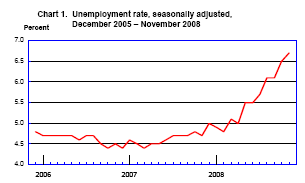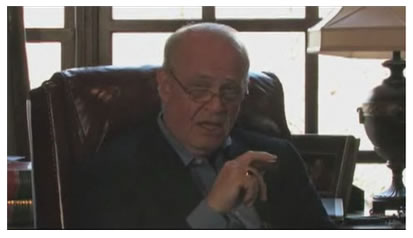Krugman Still Wrong on the Economy
Economics / Economic Theory Dec 29, 2008 - 09:04 AM GMTBy: Mike_Shedlock
 Krugman seems particularly proud of a piece he wrote a decade ago. His new remake, Hangover Theorists , is as wrong now as it was then. Let's take a look.
Krugman seems particularly proud of a piece he wrote a decade ago. His new remake, Hangover Theorists , is as wrong now as it was then. Let's take a look.
The hangover theory , which I wrote about a decade ago, is still out there. The basic idea is that a recession, even a depression, is somehow a necessary thing, part of the process of “adapting the structure of production.” We have to get those people who were pounding nails in Nevada into other places and occupation, which is why unemployment has to be high in the housing bubble states for a while.
The trouble with this theory, as I pointed out way back when, is twofold:
1. It doesn't explain why there isn't mass unemployment when bubbles are growing as well as shrinking — why didn't we need high unemployment elsewhere to get those people into the nail-pounding-in-Nevada business?
2. It doesn't explain why recessions reduce unemployment across the board, not just in industries that were bloated by a bubble.
One striking fact, which I've already written about , is that the current slump is affecting some non-housing-bubble states as or more severely as the epicenters of the bubble. Here's a convenient table from the BLS, ranking states by the rise in unemployment over the past year. Unemployment is up everywhere. And while the centers of the bubble, Florida and California, are high in the rankings, so are Georgia, Alabama, and the Carolinas.
So the liquidationists are still with us.
Let's answer Krugman's two points in reverse order starting with number 2:
" 2. It doesn't explain why recessions reduce unemployment across the board, not just in industries that were bloated by a bubble. "
The answer should be obvious, but obviously it's not. Let's take this in 10 steps, using the housing bubble as our guide.
2.A.1. What Goes Into The House
When a house is built a certain number of things go into that house: a refrigerator, stove, microwave, lighting fixtures, carpeting, fireplaces, kitchen cabinets. The house is made of brick or lumber or a combination. Someone has to make the refrigerator, stove, microwave, lighting fixtures, carpeting, fireplaces, kitchen cabinets, etc. Someone has to make the frames and trusses for the house.
The frames and trusses are more likely than not made in the US, not necessarily where the housing bubbles were. It takes workers to do that. And it takes port workers to unload the a refrigerators, stoves, microwaves, lighting fixtures, carpeting, fireplaces, kitchen cabinets etc that was no doubt made in China. Limestone, sand and gravel typically comes from nearby quarries to reduce shipping costs.
2.A.2 Shipping and Trucking
Truckers trucked all that stuff across the country. Those truckers filled up with diesel delivering the load and returning. And those truckers ate at "Joe's Diner" in the town of Wherever, USA. And the same applies to stuff sent by rail rather than truck, except that someone had to be paid to unload the rail cars.
In addition, subcontractors purchased small pickup trucks and SUVs to haul lighter freight and materials such as limestone, sand, gravel, bricks, and landscape materials.
2.A.3 Landscaping and Maintenance Items
Homeowners needed landscaping and maintenance items. They seeded their grass and bought trees and shrubs at the local nursery, and fertilizer and tools at Home Depot (HD), Lowes (LOW), Wal-Mart (WMT), or Sears (SHLD).
2.A.4 Cash Out Refis
Home prices were rising everywhere as a result of the loose money that was flowing around. Even those not buying a new home were upgrading appliances, kitchens, landscaping, etc. That stuff had to be shipped and more importantly money was readily available to anyone who wanted to "put their cash to work". And many did, buying boats (which had to be built, shipped or trucked). Others, flush with perceived wealth, took vacations. Vacations means plane tickets, car rentals, hotel bill, and lots of sight seeing and dining out. Still others used cash out refis to buy autos.
2.A.5 Commercial Real Estate
Commercial real estate follows residential with a lag. Even after it was clear housing was headed into a slump, strip malls were being built following the buildup residential. Those stores had to be stocked. More goods needed to be shipped to fill those stores.
More importantly those stores hired massive numbers of people. This was an artificial and unsustainable boom that lingered on well after residential housing popped. Indeed unemployment hit an amazingly low 4.4% early in 2007, 18 months after the housing bubble popped in the summer of 2005. I called the real estate top, in real time right here on this blog.
For an update showing where we are now and a timeline history of calls, please see Housing Update - How Far To The Bottom?

Corporations flush with cash, started building stores in Podunk USA thinking the housing boom would spread everywhere. Thus, even Podunk USA participated in the boom, even if there was no flurry of housing activity.
2.A.6 Financial Engineering
Wall Street figured out how to package mortgage loans into CDOs, CDOs squared (CDOs of CDOs), CLOs, MBS, and all sorts of other financial wizardry names. Rather than hold the debt, it became a case of hot potato to see how quickly debt could be unloaded on foreign investors, pension plans, hedge funds, and others who thought that housing prices could only go up.
That debt was sliced and diced into tranches and no one could even figure out exactly who owned what portion of any mortgage. Banks and brokerages were greedy to the end keeping the best of the debt for themselves. Eventually even the best proved to be toxic, but as long as prices were going up, profits (imaginary profits) on Wall Street soared.
2.A.7 The Stock Market Boom
The boom was exciting for stockholders. $8 trillion or so "wealth" was added to the values of IRAs, 401Ks, pension plans, and common shareholders over the course of a few years. The wealth effect supported consumption and a consumption mentality. No one needed to save for retirement, housing and the stock market would make everyone set for life. The savings rate plunged.
2.A.8 Property Taxes and Sales Taxes Soar
As a result of rising property taxes and sales tax collections, the former until the housing bubble popped, the latter kept going on for years to come as consumers continued to spend whatever equity they had left, cities and states went on equally ridiculous spending sprees. Money was wasted on all kinds of pet projects.
2.A.9 The Stock Market Bust
Residential housing imploded in 2005, commercial real estate peaked in late 2007, and at nearly the same time the stock market started imploding in what most thought would be a quick correction.
We are now on the backside of the bubble bust. That backside is called Peak Credit . Its related twin is Peak Earnings . A secular, once in a lifetime credit boom is now imploding.
2.A.10 The Shopping Center Economic Model Dies
On April 18th I wrote the Shopping Center Economic Model Is History . The boom had bust big time and unemployment started to soar as shown in the chart above. The slowdown in spending affected sales tax receipts and numerous states, especially California have to make huge budget cuts which will add to unemployement woes.
2A Summary
The reality is this was not a housing boom but a credit boom that permeated the entire global economy.
While Krugman is asking " why recessions reduce unemployment across the board, not just in industries that were bloated by a bubble " a more realistic question is "What segments of the economy were not impacted by the housing (credit) bubble?"
Nonetheless let's try it Krugman's way looking at what industries were directly impacted by the bubble.
Direct Impact of Housing Slowdown
- Manufacturing
- Retail
- Shipping
- Finance
- Construction
- Travel
- Leisure
- Restaurants
- Energy
- Commodities
- Trucks and SUVs
- City, State, Local Government Spending
- Health care
- Education
Now let's address " It doesn't explain why there isn't mass unemployment when bubbles are growing as well as shrinking "
Hopefully the answer is now crystal clear as explained by 2.A.1 through 2.A.8 above. Any eighth grader in the country should be able to understand those points.
As for " why didn't we need high unemployment elsewhere to get those people into the nail-pounding-in-Nevada business? " once again the answer should be clear.
In Austrian economic terms which Krugman being a Nobel Prize winning economist should understand but doesn't (which is a sad commentary on the state of affairs in and of itself), is that rising unemployment is a payback for an artificial boom that preceded it. Had there not been an artificial boom, and in the absence of government intervention, the free market by itself would achieve stable employment.
The artificial credit boom created huge malinvestments (overcapacity) in shopping centers, residential housing (inventory and falling prices are the tells), restaurants, strip malls, commercial real estate, trucking, autos, etc, etc. The liquidation of those malinvestments is bound to create rising unemployment. Again, any eighth grader should be able to understand this construct.
Free Lunch Theory
Keynesian economists, for which Krugman is the high priest , believe that it is possible to spend one's way out of a recession even though it was excessive spending that caused the boom and the subsequent bust.
We tried it Krugman's way once already, and the result was a housing (credit) bubble of epic proportion. Not having learned a damn thing, the typical Keynesian response is to attempt to create an even bigger bubble.
If the ideas expressed above did not convince you of the absurdity of Keynesian economics, perhaps this video will.
Fred Thompson On The Economy

Click Here To Play Video
Fred explains exactly how Krugman's theory works. It's a hilarious must see video that explains Keynesian economics in a nutshell.
Ideas So Simple, Only Academic Wonks Cannot Understand
The above ideas are so simple and so logical that they are beyond the comprehension of academic wonks. Instead, wonks hide behind formulas such as this one:
dY/dD = (1-m)/[1 - (1-t)(1-m)c - t(1-m)]
Krugman used that formula to explain why Germany should be applying more fiscal stimulus. I took the other side of the argument in a pair of articles.
- Fiscal Insanity Virus Rapidly Spreading The Globe (Part 1)
- Fiscal Insanity Virus Rapidly Spreading The Globe (Part 2)
Sadly, the free lunch theory of economics is what is being taught in universities throughout the world. The Fiscal Inanity Virus, FIV, is on a rampage.
By Mike "Mish" Shedlock
http://globaleconomicanalysis.blogspot.com
Click Here To Scroll Thru My Recent Post List
Mike Shedlock / Mish is a registered investment advisor representative for SitkaPacific Capital Management . Sitka Pacific is an asset management firm whose goal is strong performance and low volatility, regardless of market direction.
Visit Sitka Pacific's Account Management Page to learn more about wealth management and capital preservation strategies of Sitka Pacific.
I do weekly podcasts every Thursday on HoweStreet and a brief 7 minute segment on Saturday on CKNW AM 980 in Vancouver.
When not writing about stocks or the economy I spends a great deal of time on photography and in the garden. I have over 80 magazine and book cover credits. Some of my Wisconsin and gardening images can be seen at MichaelShedlock.com .
© 2008 Mike Shedlock, All Rights Reserved
Mike Shedlock Archive |
© 2005-2022 http://www.MarketOracle.co.uk - The Market Oracle is a FREE Daily Financial Markets Analysis & Forecasting online publication.



